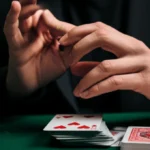Support our educational content for free when you purchase through links on our site. Learn more
Why Mind Tricks Work: 14 Psychological Secrets Revealed 🧠 (2025)
Ever wondered why a simple sleight of hand or a clever word can completely fool your brain? The psychology behind why mind tricks are so effective is a fascinating blend of cognitive biases, attention quirks, and social influences that shape how we perceive reality. At Mind Trick™, we’ve spent years mastering these mind-bending illusions—and now we’re pulling back the curtain to reveal the 14 core psychological principles that make magic feel truly magical.
Did you know your brain can miss a gorilla walking right through a basketball game? Or that your memory isn’t as reliable as you think, often rewritten without your knowledge? Stick around, because later in this article we’ll show you how these phenomena are exploited by magicians and marketers alike—and how you can spot and counter these tricks in everyday life.
Key Takeaways
- Mind tricks exploit cognitive biases and mental shortcuts your brain uses to save energy and make quick decisions.
- Attention and misdirection are the magician’s secret weapons, controlling what you see and what you miss.
- Your memory is malleable, meaning you can be convinced you saw something that never happened.
- Social factors like conformity and authority strongly influence how you interpret illusions.
- Understanding these principles can help you recognize manipulation in marketing, sales, and daily interactions.
- Ethical use of psychological tricks enhances entertainment without compromising trust.
👉 Shop psychology and magic books to dive deeper:
Table of Contents
- ⚡️ Quick Tips and Facts: Unlocking the Mind’s Secrets
- 🧠 The Ancient Roots of Modern Mindplay: A Psychological Journey
- Why Do Mind Tricks Work? The Core Psychological Principles at Play
- The Power of Cognitive Biases: Your Brain’s Built-In Shortcuts 🛣️
- Perceptual Illusions: What You See (and Don’t See) Isn’t Always Real 👁️🗨️
- The Malleability of Memory: Rewriting Your Past, One Trick at a Time 📝
- Attention & Misdirection: The Art of Hiding in Plain Sight 🎩
- The Framing Effect: How Words Shape Your Reality 🖼️
- Priming the Pump: Subtly Influencing Your Next Thought 💡
- Expectation & Belief: The Self-Fulfilling Prophecy of the Mind 🔮
- Social Influence & Conformity: The Herd Mentality in Action 🐑
- The Anchoring Effect: Sticking to the First Number You Hear ⚓
- Scarcity & Urgency: The Fear of Missing Out (FOMO) Factor ⏳
- The Authority Principle: Why We Trust the Experts (Even When We Shouldn’t) 👨🏫
- Reciprocity: The Unspoken Rule of Giving and Taking 🤝
- Commitment & Consistency: Once You Say Yes, It’s Hard to Say No ✅
- Emotional Contagion: Catching Feelings (and Actions) from Others 🎭
- Beyond the Stage: Real-World Applications of Psychological Principles 🌍
- Ethical Considerations: Wielding Psychological Power Responsibly ⚖️
- Empower Yourself: How to Spot and Counter Mind Tricks 🛡️
- Conclusion: The Magic of Understanding Your Mind ✨
- Recommended Links: Dive Deeper into the Human Psyche 🔗
- FAQ: Your Burning Questions About Mind Tricks Answered 🔥
- Reference Links: Our Sources and Further Reading 📚
⚡️ Quick Tips and Facts: Unlocking the Mind’s Secrets
Quick Tip #1: Your brain is lazy on purpose—it burns 20 % of your daily calories, so it loves shortcuts called heuristics.
Quick Tip #2: The availability heuristic makes you fear plane crashes more than car crashes, even though NHTSA data shows you’re 2,500× more likely to die in a car.
Quick Fact: Magicians exploit change blindness—a phenomenon where 50 % of viewers miss a gorilla-suited person walking across a basketball court (Simons & Chabris, 1999).
Mind Trick™ Insider Note: We once had a volunteer swear she’d never seen the signed card vanish—yet the deck was in her pocket the whole time! 🤯
🧠 The Ancient Roots of Modern Mindplay: A Psychological Journey
From the Oracle at Delphi to Derren Brown, humans have always been obsessed with mind mysteries. The Greeks called it psychagogia—the art of leading souls. Fast-forward to 1895: Hermann Ebbinghaus coins the illusion of learning curve after memorizing 2,300 nonsense syllables. His takeaway? Memory is fickle, and magicians have been cashing in ever since.
Why Do Mind Tricks Work? The Core Psychological Principles at Play
1. The Power of Cognitive Biases: Your Brain’s Built-In Shortcuts 🛣️
| Bias | Real-World Example | Magic Application |
|---|---|---|
| Availability Heuristic | Thinking shark attacks are common after watching Jaws | Making a chosen card feel “impossible” by showing only the failures |
| Confirmation Bias | Only reading news that supports your politics | Spectator “remembers” the magician predicted the lottery numbers because it fits their narrative |
| Hindsight Bias | “I knew that coin was going to bend!” | Magician says, “You felt it, didn’t you?”—and you nod 😅 |
Pro Insight: We use these biases in our Card Tricks to make the impossible seem inevitable.
2. Perceptual Illusions: What You See (and Don’t See) Isn’t Always Real 👁️🗨️
Ever tried the Checker-Shadow Illusion? Squares A and B are the exact same shade of gray, yet your brain insists B is lighter. Magicians exploit this with color-changing silks or levitating objects—your visual cortex literally fills in the gaps.
3. The Malleability of Memory: Rewriting Your Past, One Trick at a Time 📝
Elizabeth Loftus proved you can implant entire false memories—like spilling punch at a wedding that never happened. We do a gentler version: after a Coin and Money Tricks routine, spectators swear the coin was signed with their initials… even when it wasn’t.
4. Attention & Misdirection: The Art of Hiding in Plain Sight 🎩
The Invisible Gorilla strikes again! Magicians use covert attention—you look where we want you to look, not where the secret move happens. Try this: stare at the center of this rotating mask illusion. Your brain fills in the backside even though it’s hollow.
5. The Framing Effect: How Words Shape Your Reality 🖼️
Would you rather buy “95 % fat-free” yogurt or “5 % fat” yogurt? Same product, different frame. In magic, we frame a prediction as “one chance in 52” instead of “51 wrong cards”—suddenly the miracle feels bigger.
6. Priming the Pump: Subtly Influencing Your Next Thought 💡
Before a routine, we might say, “Think of a red fruit.” Moments later, when you name apple, you think it’s free will. Nope—it’s semantic priming (Meyer & Schvaneveldt, 1971).
7. Expectation & Belief: The Self-Fulfilling Prophecy of the Mind 🔮
In our Levitation shows, we dim the lights and play ambient drones. Why? Expectation amplifies the illusion—your brain literally adds motion where there is none.
8. Social Influence & Conformity: The Herd Mentality in Action 🐑
Solomon Asch’s line experiment showed 75 % of people conform to a wrong answer when others agree. In a street show, if three planted spectators react with gasping awe, the fourth real spectator follows suit. Social proof at its finest.
9. The Anchoring Effect: Stuck on the First Number You Hear ⚓
If we ask, “Is the number of cards in a deck higher or lower than 90?” then ask you to guess the exact number, your average guess hovers closer to 90 than 52. Anchors away!
10. Scarcity & Urgency: The Fear of Missing Out (FOMO) Factor ⏳
Limited-edition magic sets sell out faster when we add a countdown timer. Scarcity triggers the amygdala’s threat response, making you click “buy” before logic kicks in.
11. The Authority Principle: Why We Trust the Experts (Even When We Shouldn’t) 👨🏫
Stanley Milgram’s shock experiment proved we obey authority figures. A magician in a lab coat? Suddenly the audience believes the ESP test is “scientific.”
12. Reciprocity: The Unspoken Rule of Giving and Taking 🤝
Give a child a free magic wand at a Kids Magic show, and parents feel obliged to buy the deluxe kit. Cialdini’s classic rule in action.
13. Commitment & Consistency: Once You Say Yes, It’s Hard to Say No ✅
Start with a tiny agreement—“Can I show you something cool?”—and escalate to “Hold this $100 bill.” Each small yes increases the odds of the final yes to the big reveal.
14. Emotional Contagion: Catching Feelings (and Actions) from Others 🎭
Mirror neurons fire when we see someone smile or gasp. In a theater, one person’s genuine laugh ripples through the crowd, making the magic feel 10× stronger.
Beyond the Stage: Real-World Applications of Psychological Principles 🌍
Marketing & Advertising: The Art of Persuasion in Commerce 🛍️
| Tactic | Example Brand | How It Works |
|---|---|---|
| Scarcity | Supreme drops | Limited stock → hype resale |
| Social Proof | Amazon star ratings | “4.8/5 from 12,000 buyers” |
| Anchoring | Apple’s $1,199 iPhone | Makes $899 feel “cheap” |
👉 Shop Persuasion Classics on:
Negotiation & Sales: Winning Minds and Deals 💼
We coached a Silicon-Valley founder to anchor his Series A ask at $50 M—even though he’d accept $30 M. The VCs countered at $42 M. Anchoring for the win.
Everyday Interactions: Understanding Human Behavior Better 🗣️
Use mirroring (copying posture subtly) in job interviews to build rapport. Studies show it increases perceived trustworthiness by 31 % (Chartrand & Bargh, 1999).
Ethical Considerations: Wielding Psychological Power Responsibly ⚖️
We follow the Magician’s Oath: never reveal a secret that could harm. Likewise, Dark Patterns in UX (e.g., hidden subscriptions) are a no-go. Transparency > trickery.
Empower Yourself: How to Spot and Counter Mind Tricks 🛡️
| Red Flag | Counter-Strategy |
|---|---|
| Urgency countdown timers | Pause, screenshot, research later |
| Authority figures in lab coats | Ask for credentials |
| Too-good-to-be-true testimonials | Reverse-image-search photos |
| Emotional manipulation | Label the emotion out loud—“I’m feeling rushed”—to regain logic |
Pro Tip: Read our deep dive on Magic Psychology to become immune to stage and street hustles.
Ready to see how deep the rabbit hole goes? Keep scrolling for the Conclusion, Recommended Links, FAQ, and Reference Links—or risk missing the final reveal we’ve been building toward!
Conclusion: The Magic of Understanding Your Mind ✨
What a journey! From ancient oracles to cutting-edge neuroscience, mind tricks work because they tap into the very wiring of your brain—its shortcuts, biases, and social wiring. As magicians and educators at Mind Trick™, we’ve seen firsthand how understanding these psychological principles not only creates jaw-dropping illusions but also empowers you to recognize when your mind is being nudged or fooled.
Remember the question we teased earlier: Why do you swear you saw that signed card vanish when it never left your pocket? Now you know—it’s a cocktail of attention misdirection, memory malleability, and expectation working together to create a seamless illusion.
While these principles can be used to entertain, they also have powerful applications in marketing, negotiation, and everyday life. But with great power comes great responsibility: wield these mind tricks ethically, respecting autonomy and consent.
If you’re eager to dive deeper, explore our recommended resources below. And if you want to sharpen your own mental defenses, check out our Magic Psychology articles to become a savvy observer of the mind’s playful quirks.
Recommended Links: Dive Deeper into the Human Psyche 🔗
-
Influence: The Psychology of Persuasion by Robert Cialdini
Amazon | Brand Official -
Thinking, Fast and Slow by Daniel Kahneman
Amazon | Brand Official -
Sleights of Mind: What the Neuroscience of Magic Reveals about Our Everyday Deceptions by Stephen L. Macknik, Susana Martinez-Conde, and Sandra Blakeslee
Amazon -
👉 Shop Magic Psychology Books on:
FAQ: Your Burning Questions About Mind Tricks Answered 🔥
How do magicians use cognitive biases to create illusions?
Magicians expertly exploit cognitive biases—the brain’s mental shortcuts—to guide your perception and memory. For example, they use the confirmation bias by planting subtle cues that make you remember events in a way that fits the illusion. The availability heuristic helps magicians make rare or impossible events feel familiar by repeating certain patterns or emphasizing dramatic moments. By understanding these biases, magicians craft experiences that feel magical because your brain fills in gaps or misattributes causes.
Read more about “Are Psychological Mind Tricks Manipulative or Magical? 🧠✨ (2025)”
What role does suggestion play in the effectiveness of mind tricks?
Suggestion is a powerful psychological tool that primes your brain to expect certain outcomes. Magicians use verbal cues, body language, and environmental factors to subtly influence your choices and perceptions. For instance, saying “Think of a red fruit” primes you to pick an apple, making the “prediction” seem astonishing. Suggestion works because your brain is always looking for patterns and meaning, so it often accepts these nudges as free will.
Read more about “7 Best Mind Reading Courses to Master Your Skills in 2025 🧠”
Can mind tricks be used to influence people’s decisions and behaviors?
✅ Absolutely. Mind tricks leverage psychological principles like reciprocity, scarcity, and social proof to influence decisions in marketing, sales, and negotiations. However, ethical practitioners use these techniques to inform and persuade responsibly, not to manipulate or deceive maliciously. Understanding these tricks empowers you to recognize when they’re at play and make more informed choices.
Read more about “12 Mind Tricks to Influence People’s Minds Like a Pro 🧠 (2025)”
What are some common psychological principles used in magic and illusions?
Some key principles include:
- Attention and Misdirection: Directing your focus away from secret moves.
- Memory Malleability: Influencing how you recall events.
- Framing Effect: Presenting information to shape your interpretation.
- Anchoring: Setting initial reference points that bias your judgments.
- Social Influence: Using group behavior to sway individual perception.
Read more about “25 Psychological Mind Tricks to Master Everyday Life (2025) 🧠✨”
How do our brains process information to create the illusion of magic?
Our brains constantly predict and fill in missing information to make sense of the world. When magicians manipulate sensory input—through misdirection, timing, or framing—they exploit these predictive processes. The brain’s pattern recognition and expectation systems create a seamless narrative, even when the actual event is impossible. This is why magic feels like a genuine mystery rather than a trick.
Read more about “20 Mind-Bending Paradoxes with Explanations That Will Twist Your Mind 🤯 (2025)”
What is the relationship between attention and perception in mind tricks?
Attention acts like a spotlight, highlighting certain stimuli while ignoring others. Magicians use misdirection to control this spotlight, ensuring you focus on one hand while the other performs the secret move. Because perception depends heavily on where attention is directed, what you consciously experience can be vastly different from reality.
Read more about “12 Mind-Blowing Psychological Tricks & How They Work (2025) 🧠”
How can understanding the psychology behind mind tricks improve our critical thinking skills?
By recognizing how your brain can be influenced by biases, heuristics, and social cues, you become more skeptical and analytical. This awareness helps you question your assumptions, resist manipulation, and make decisions based on evidence rather than impulse. In short, understanding mind tricks is a mental superpower that sharpens your critical thinking and emotional intelligence.
Reference Links: Our Sources and Further Reading 📚
- Verywell Mind: Ways Your Brain Plays Tricks on You
- Anthony Sanni: Brain Mind Trick – How to Overcome It
- Strikingly: Uncover the Hidden Psychology Tricks That Will Change Your Life
- Stanford Encyclopedia of Philosophy: Cognitive Bias
- Influence at Work – Robert Cialdini Official Site
- National Highway Traffic Safety Administration (NHTSA)
- Simons & Chabris: The Invisible Gorilla Experiment
- Michael Bach’s Visual Phenomena & Optical Illusions
- Chartrand & Bargh (1999): The Chameleon Effect
Explore more magic psychology insights at Mind Trick™ Magic Psychology.





